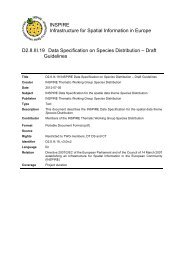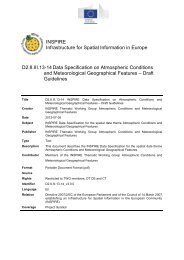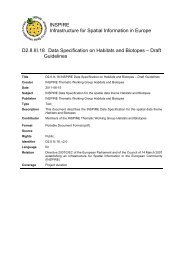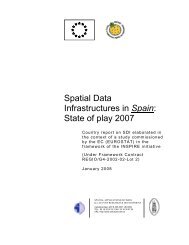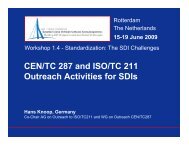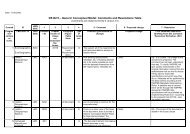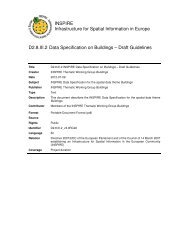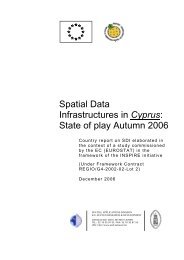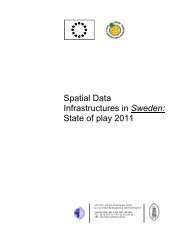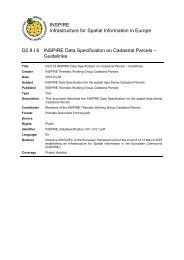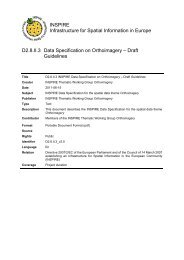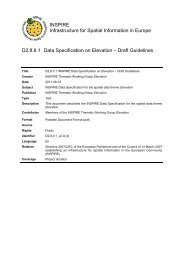Production and Industrial Facilities - INSPIRE - Europa
Production and Industrial Facilities - INSPIRE - Europa
Production and Industrial Facilities - INSPIRE - Europa
You also want an ePaper? Increase the reach of your titles
YUMPU automatically turns print PDFs into web optimized ePapers that Google loves.
<strong>INSPIRE</strong> Reference: D2.8.III.8_v2.0(.0)<br />
TWG-PF Data Specification on <strong>Production</strong> <strong>and</strong><br />
<strong>Industrial</strong> <strong>Facilities</strong><br />
2011-06-15 Page<br />
DS Requirement 3 All information that is required by a calling application to be able to retrieve the<br />
data through the used network service shall be made available in accordance<br />
with the requirements defined in the Implementing Rules on Network Services.<br />
EXAMPLE 1 Through the Get Spatial Objects function, a download service can either download a predefined<br />
data set or pre-defined part of a data set (non-direct access download service), or give direct<br />
access to the spatial objects contained in the data set, <strong>and</strong> download selections of spatial objects based<br />
upon a query (direct access download service). To execute such a request, some of the following<br />
information might be required:<br />
the list of spatial object types <strong>and</strong>/or predefined data sets that are offered by the download service (to<br />
be provided through the Get Download Service Metadata operation),<br />
<strong>and</strong> the query capabilities section advertising the types of predicates that may be used to form a<br />
query expression (to be provided through the Get Download Service Metadata operation, where<br />
applicable),<br />
a description of spatial object types offered by a download service instance (to be proviced through<br />
the Describe Spatial Object Types operation).<br />
EXAMPLE 2 Through the Transform function, a transformation service carries out data content<br />
transformations from native data forms to the <strong>INSPIRE</strong>-compliant form <strong>and</strong> vice versa. If this operation is<br />
directly called by an application to transform source data (e.g. obtained through a download service) that<br />
is not yet conformant with this data specification, the following parameters are required:<br />
Input data (m<strong>and</strong>atory). The data set to be transformed.<br />
Source model (m<strong>and</strong>atory, if cannot be determined from the input data). The model in which the input<br />
data is provided.<br />
Target model (m<strong>and</strong>atory). The model in which the results are expected.<br />
Model mapping (m<strong>and</strong>atory, unless a default exists). Detailed description of how the transformation is<br />
to be carried out.<br />
Encodings<br />
Default Encoding(s)<br />
Data conformant to the application schema(s) defined in section 5.2 shall be encoded using the<br />
encoding(s) specified in this section.<br />
Default encoding for application schema <br />
Name: GML Application Schema<br />
Version: version , GML, version 3.2.1<br />
Specification: D2.8.III.8 Data Specification on <strong>Production</strong> <strong>and</strong> <strong>Industrial</strong> <strong>Facilities</strong> – Draft Guidelines<br />
Character set: UTF-8<br />
The GML Application Schema is distributed in a zip-file separately from the data<br />
specification document.<br />
Implementation UML model used for generating the GML application schema<br />
The GML application schema was not derived directly from the conceptual model<br />
described in section 5, but from an implementation model (for a schematic illustration of<br />
this process, see Figure 2).<br />
LXIX




